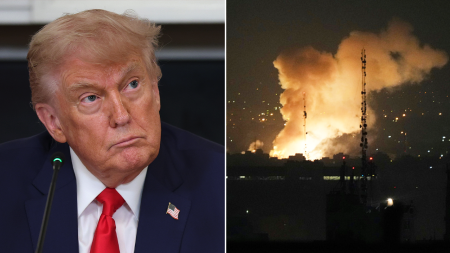The re-emergence of a controversy surrounding the auctioning of border wall materials has prompted Senator Bill Hagerty (R-TN) to introduce legislation aimed at halting the federal government’s disposal of these resources. Hagerty’s bill seeks to prohibit the use of federal funds for any actions that would render sections of the border wall inoperable, including deconstruction, dismantling, or any other form of disabling. Furthermore, the legislation aims to prevent the government from selling, transferring, or otherwise disposing of any materials acquired for the construction, maintenance, or reinforcement of the barrier along the U.S.-Mexico border. This legislative action comes as a direct response to the Biden administration’s ongoing auctioning of border wall materials, a practice that has sparked criticism, particularly from former President Trump and his supporters.
The controversy stems from the Biden administration’s decision to halt border wall construction in January 2021, leaving behind a substantial quantity of unused materials. These materials, initially purchased during the Trump administration’s push for enhanced border security, have been progressively auctioned off via GovPlanet.com, an online auction platform. The Defense Department has stated that these materials, deemed excess by the Army Corps of Engineers, were transferred for disposal and subsequent sale. The auctions have reportedly been occurring weekly, with recent reports and video footage highlighting the transport of unused wall segments, igniting renewed debate over the fate of these resources. Former President Trump, anticipating a return to office, has vehemently condemned these actions, labeling them as “almost criminal” and urging an immediate halt to the sales.
Former President Trump’s contention rests on the premise that these materials will be necessary for his planned resumption of border wall construction. He argues that selling these materials now only serves to inflate future rebuilding costs, potentially costing taxpayers hundreds of millions of dollars. He has been collaborating with Texas Attorney General Ken Paxton and other Texas officials to explore avenues for reclaiming these materials. This underscores the deep political divide surrounding border security and the contrasting approaches of the Trump and Biden administrations. The controversy surrounding the wall’s construction and subsequent dismantling reflects the broader ideological clash over immigration policy and border control.
The Department of Defense maintains that the disposal of these materials is in accordance with the fiscal year 2024 National Defense Authorization Act (NDAA). This act mandated that the Secretary of Defense devise a plan for the utilization, transfer, or donation of all remaining wall materials procured using Pentagon funds. The plan, submitted in March, reportedly prioritized border states, including Texas and California, in the distribution of materials. The Defense Department asserts that the materials sold through GovPlanet no longer belong to the government, effectively relinquishing any legal authority to halt their resale. This legal position complicates any attempts to reclaim the materials, creating a potential legal battleground.
Senator Hagerty’s proposed legislation, however, aims to supersede the NDAA provision, specifically targeting the disposal of border wall materials. Hagerty’s office argues that the NDAA provision was originally intended to facilitate border wall construction, not its deconstruction. This interpretation sets the stage for a potential legislative clash, with the outcome potentially hinging on the balance of power in Congress and the broader political climate surrounding border security. The legislative battle reflects the ongoing struggle between those advocating for increased border security and those prioritizing other approaches to immigration and border management.
The controversy encompasses a multitude of complex issues, ranging from budgetary considerations and legal interpretations to broader ideological clashes on border security and immigration policy. The fate of these border wall materials remains uncertain, contingent on the legislative process, potential legal challenges, and the ultimate direction of federal border security policy under the next administration. The outcome will significantly impact not only the physical border landscape but also the broader political discourse surrounding immigration and national security in the United States. It represents a critical juncture in the ongoing debate about border security, with substantial implications for future policy and resource allocation.










